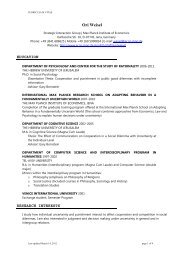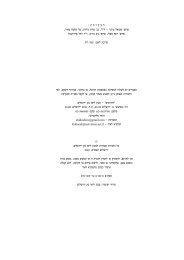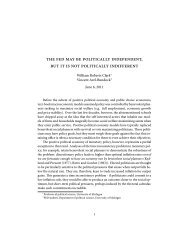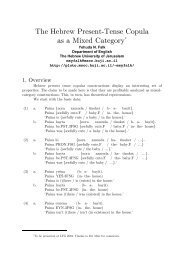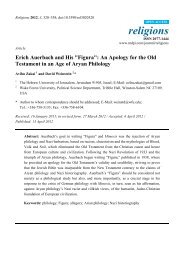Transitive verbs with non-accusative alternation in ... - Pluto Huji Ac Il
Transitive verbs with non-accusative alternation in ... - Pluto Huji Ac Il
Transitive verbs with non-accusative alternation in ... - Pluto Huji Ac Il
You also want an ePaper? Increase the reach of your titles
YUMPU automatically turns print PDFs into web optimized ePapers that Google loves.
84<br />
Rivka Halevy<br />
entity O, described above as signify<strong>in</strong>g <strong>in</strong>tention to go on <strong>with</strong> the action<br />
or, <strong>in</strong> aspectual terms, extension of the <strong>in</strong>gressive <strong>in</strong>to the durative (cf.<br />
Section 2.1.2).<br />
F<strong>in</strong>ally, the focus on the contact (viz., giv<strong>in</strong>g the O a high profile) may<br />
also become lexicalized. For <strong>in</strong>stance, besides hika ‘hit’, which can<br />
alternatively be construed <strong>in</strong> the <strong>accusative</strong> and <strong>in</strong> the prepositional,<br />
Hebrew also has lexicalized <strong>verbs</strong> that <strong>in</strong>corporate the notion of contact<br />
between the core participants <strong>in</strong> their lexical structure and are, therefore,<br />
conf<strong>in</strong>ed to the be- construction, e.g. paga’ ‘hit + cause harm’ and halam<br />
‘strike <strong>with</strong> an heavy <strong>in</strong>strument’. In (45), hika be- can be replaced by the<br />
nearly sy<strong>non</strong>ymous paga’ be- and halam be-, s<strong>in</strong>ce all reflect the same<br />
event structure and the same mean<strong>in</strong>g-pattern, viz., imperfectivity, partcentered<br />
view, <strong>in</strong>tentionality, and so on.<br />
(45) ha-de’a ha-kelalit hi’ še-hateroristim hiku bahem<br />
mipney še-hem amerika’im (Haaretz, 13.9.01)<br />
the-op<strong>in</strong>ion the-general is that-the-terrorists struck <strong>in</strong>-them<br />
because that-they-are Americans<br />
‘The general op<strong>in</strong>ion is that the terrorists struck them because they<br />
were Americans’<br />
5.2. Further syntactic properties of <strong>verbs</strong> of contact by motion<br />
Further exam<strong>in</strong>ation of the relation between the notions of ‘motion’ and<br />
‘contact’ and the syntactic behavior of the transitive <strong>verbs</strong> at issue reveals<br />
that, apart from the ‘et/be- <strong>alternation</strong> that is sensitive both to motion and<br />
contact, other transitivity <strong>alternation</strong>s are sensitive either to the notion of<br />
‘contact’ or to the notions of ‘motion’ and ‘change of state’. 19 In what<br />
follows, I shall exam<strong>in</strong>e four types of transitivity <strong>alternation</strong>s: (1) body-part<br />
possessor ascension; (2) <strong>in</strong>choative <strong>alternation</strong>; (3) middle-passive<br />
<strong>alternation</strong>; and (4) passivization.<br />
5.2.1. Body-part possessor ascension<br />
The construction of body-part possessor ascension is realized by ascension<br />
of the body-part possessor to the position of a direct or <strong>in</strong>direct object<br />
(usually encoded <strong>in</strong> the possessive dative le-) while mov<strong>in</strong>g the possessed<br />
body-part to a tertiary position (<strong>in</strong> the sense of O. Jespersen), namely an<br />
adverbial position. From the cognitive viewpo<strong>in</strong>t it represents a whole-



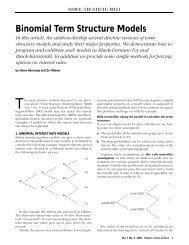
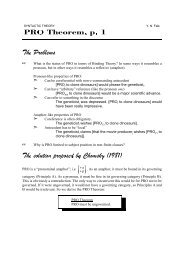
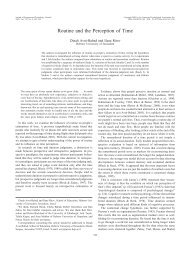
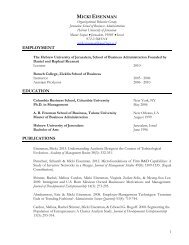
![CV [PDF] - Pluto Huji Ac Il](https://img.yumpu.com/18174585/1/190x245/cv-pdf-pluto-huji-ac-il.jpg?quality=85)

